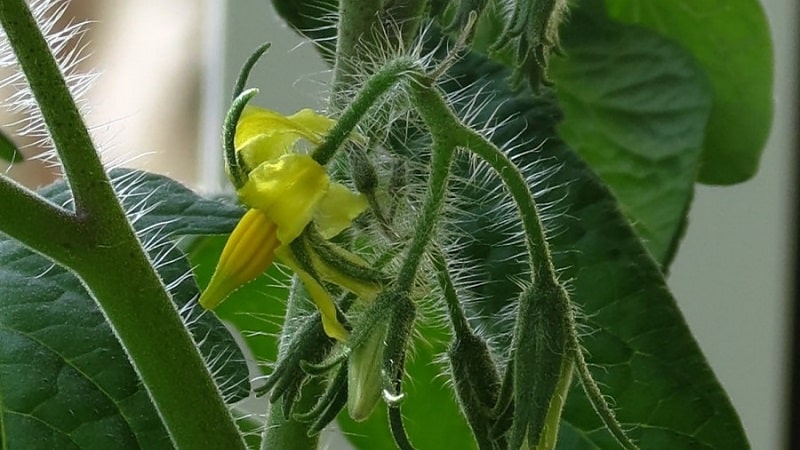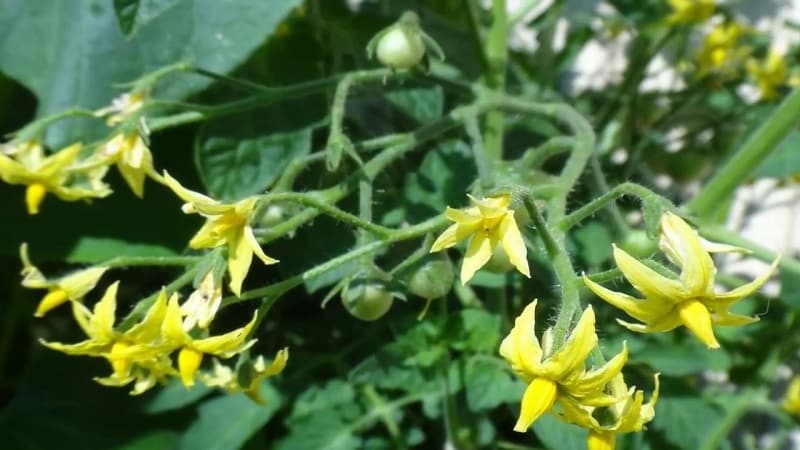What to do if tomatoes bloom in a greenhouse but there are no ovaries?
It’s not for nothing that Italians call tomatoes golden apples. This vegetable has a rich composition and excellent taste. In Russia, tomatoes rightfully occupy a place of honor on the table.
Getting a decent harvest of this crop is not so easy. Creating the necessary conditions for flowering, growth and ripening of fruits requires considerable effort. We will tell you how to care for tomatoes in a greenhouse so that the ovaries form correctly and in sufficient quantity.
Reasons for the absence of ovaries on bushes
Tomatoes are a very finicky crop. The formation of ovaries is influenced by many factors. The main ones are listed below.
Disturbed temperature regime
The plant is sensitive to temperature changes. Violation of the temperature regime often causes a large number of barren flowers.
Attention! If the stems and leaves of a tomato bush develop well, but the flowers are small and weak, this is a clear sign of a lack of heat.
Tomato pollen is formed at night and ripens at a temperature not lower than +15 ° C. Often in open ground there is no ovary on tomatoes precisely for this reason. Pollination occurs during the day. If it is too hot at this time (above 30°C), the pollen will become sterile and pollination will not occur.
The optimal temperature range is from +15 to +25 °C. Just one too hot day can destroy the entire harvest!
 Therefore, on hot days the greenhouse must be ventilated.Dark barrels of cold water help prevent overheating; they accumulate excess heat.
Therefore, on hot days the greenhouse must be ventilated.Dark barrels of cold water help prevent overheating; they accumulate excess heat.
If the weather is cold, heaters are installed. Watered tomatoes only with warm water.
If the weather is not stable, the successful formation of ovaries is facilitated by the use of modern means that improve fertilization. These are drugs such as “Ovary”, “Bud”, “Gibbersib”, “Tomaton” and others. Treat plants according to instructions.
Among folk remedies, spraying bushes with a weak solution of iodine is popular.
Poor quality seed material
It is better to purchase seeds from trusted stores and from reliable manufacturers. Be sure to pay attention to the production date and expiration date indicated on the packaging. Poor quality seeds will not germinate or the seedlings will grow weak and sick.
If you prepared the seed yourself, carefully inspect it before planting. Remove seedsthat have changed color or become moldy. Soak the rest in a weak solution of potassium permanganate for half an hour and dry.
Need to know! Hybrid tomato varieties marked F1 do not produce offspring the following year. There is no point in collecting seeds from such tomatoes.
Too many buds on the bush
The number of ovaries formed directly depends on the number of stems and branches. It is important to limit the growth of the bush in a timely manner, not allowing it to grow freely.
Removing excess shoots that distract the plant from setting fruit increases yield. Especially if the summer in your area is short.
It is optimal to grow a tomato bush with 1-2 stems, preventing the outflow of nutrients into new branches. If you leave more stems, the plant will not have time to grow large fruits; they simply will not have enough heat and time.
The lower leaves and those that shade neighboring bushes are also removed.

Lack of sunlight
Crops grown in a greenhouse are dependent on sunlight. Insufficient lighting is a common reason why there are no or very few formed fruits.
Pay attention to how your greenhouse is positioned relative to the sun. The ideal location is high, open, not shaded by trees or bushes.
If there are a lot of trees on the site and it is a pity to uproot them, position the greenhouse so that the sun illuminates it from morning until noon. Then the tomato bushes will grow strong and healthy. In addition, sunlight helps tomatoes tolerate cold better.
Advice. Regularly clean the film or glass of the greenhouse from dust and dirt. A dusty coating “eats” 10-20% of sunlight.
Diseases and pests
Often the reason for the absence of ovaries or a small number of them are diseases and pests.
One of the most dangerous diseases is gray rot. This is a fungus that spreads quickly, covering the plant with gray spots. The disease affects the stems, leaves and inflorescences of tomatoes. For prevention, the lower leaves on each plant are removed, ensuring a full flow of air to the bush. The greenhouse is regularly ventilated. Avoid high air humidity and waterlogging of the soil.
If the disease appears, the damaged leaves are cut off and destroyed away from the place where the tomatoes are grown. The damaged stem is treated with chalk or Fundazol. They also use folk remedies, for example, garlic, which they rub on sore spots.
Another common disease is late blight. The infection can be recognized by dried, curled leaves with brown spots.The disease develops quickly and affects both mature fruits and ovaries. Late blight appears in conditions of high humidity. Watering using drip irrigation and timely ventilation helps to avoid excess moisture. Treatment with Pentafag or Mikosan also applies to preventive measures. If the disease does appear, the drugs Antrakol, Acrobat and Bordeaux mixture.
Among the many parasites that infect tomatoes, the most dangerous is the spider mite. This small insect settles on the lower part of the plant, entwines it with a web and sucks the juice from the leaves. As a result, the bush begins to dry out and die. Spider mites prefer dry air, so they most often harm tomatoes with scanty watering or infrequent ventilation.
Prevention consists of timely watering and ventilation, removing weeds, and loosening the soil. If a pest is detected, the affected leaves are removed, and the plant and the soil underneath are treated with Fitoverm.
Whitefly is another pest that affects tomato bushes. It is a small insect with a yellowish body and two pairs of white wings. Damage to plants is caused by larvae that attach to leaves and feed on their juices. As a result, the bushes dry out and die. The pest is controlled using the drugs “Phosbecid” and “Cytkor”. The bushes are sprayed in the morning or evening after sunset in accordance with the instructions.

Lack of pollination
Pollination of tomatoes grown in open ground occurs naturally, with the help of wind and insects. There are no such helpers in the greenhouse. Natural pollination in closed ground is facilitated by drafts and plants that attract bees.
If this was not enough and there are few ovaries, their number is increased manually, for example, by lightly shaking branches with flowers. After this, the air is humidified with warm water from a spray bottle so that the pollen is attached to the flowers.
Attention! Visual inspection will help determine whether pollination has occurred or not. A pollinated flower's petals are open and tilted back.
Ways to increase the number of ovaries
It often happens that the bushes look healthy and bloom well, but the tomatoes do not set. Humidity control, proper fertilization, timely watering and good lighting will help correct the situation.
Humidity control
A hygrometer will help you establish and control the actual humidity in the greenhouse. This simple device allows you to accurately determine the percentage of moisture content in the air.
High humidity (more than 60%) occurs during and immediately after watering. Ventilation solves the problem.
Low humidity causes long-term heating of the greenhouse on sunny days. Containers of water and watering the paths inside the greenhouse will help regulate the moisture content in the air. You can also periodically spray the plants with a spray bottle.
Proper feeding
Competent feeding stimulate the formation of a large number of ovaries. Fertilizers begin to be applied before flowering.
To form strong buds and a powerful root system, tomatoes are fed with a urea solution: 50 g of fertilizer per 10 liters of water.
Phosphorus and potassium fertilizers are applied when the first inflorescence begins to form. For 10 liters of water use 10 g of each fertilizer.
Treating the foliage with a solution of copper sulfate (2 g per 1 liter of water) will protect the crop from disease.Disease-affected plants do not have the strength to set fruit, so prevention is extremely important.
Lighting
The culture is demanding on lighting, especially during the period of ovary formation. During light starvation, the leaves turn yellow, as if there is a lack of nutrition, the bushes shed buds and ovaries, and a lot of barren flowers are formed. The lack of lighting cannot be compensated for by either care or feeding.
To obtain a good harvest, tomatoes need at least 12 hours of lighting per day. When organizing a greenhouse, choose an open place to make the most of sunlight.

Watering
Before the formation of ovaries and fruits, tomato bushes do not need a lot of moisture. During this period, it is enough to water the tomatoes 1-2 times a week.
During the ripening period, the bushes are watered more often. However, it should be remembered that excess moisture causes fungal diseases.
Always water tomatoes at the root, avoiding water getting on the leaves and stems of the plant. It is preferable to use drip irrigation, which preserves the structure of the top layer of soil and avoids high humidity in the greenhouse.
Conclusion
So, the answer to the question of what to do if tomatoes bloom in a greenhouse, but there are no ovaries, can be formulated as follows: monitor the temperature, lighting, humidity, carry out disease prevention, apply fertilizers in a timely and competent manner. Care for your tomatoes properly from the moment they sprout, and they will delight you with an excellent harvest!